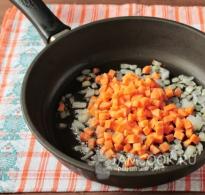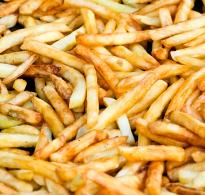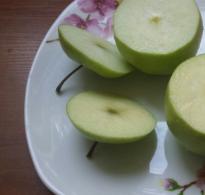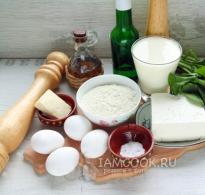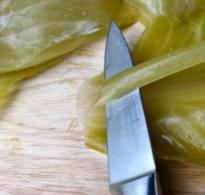Is summer honey fungus edible or not? Summer honey mushrooms: description of appearance, collection location and ways to distinguish them from false mushrooms
Meadow mushrooms (Marasmius oreades) often called non-rot mushrooms, marasmius, meadow mushrooms or clove mushrooms. After adding water to dried mushrooms, they come back to life and can produce spores. Many mushroom pickers have seen a picture where, after rain, dry honey mushrooms “came to life” again and continued to bear fruit.
Below you can see photos and descriptions of meadow mushrooms, find out what they look like and when to collect these mushrooms.
What do meadow mushrooms look like?
The cap (diameter 3-9 cm) is ocher, red-brown or yellowish. In dry weather, the cap of the honey fungus mushroom fades to a light brown or cream color, and in humid weather it becomes sticky and sticky. It has the shape of a hemisphere with a small central tubercle, which over time changes to a slightly convex or almost prostrate shape. The edges are uneven and ribbed, almost transparent, paler than the center.


The photo shows what meadow honey mushrooms look like: the stem of these mushrooms, 4-11 cm high, is thin and sinuous, has a cylindrical shape and tapers slightly from bottom to top. It is velvety to the touch, with a slight powdery coating. The color rarely differs from the cap.


Records: ocher or light cream. In young mushrooms they grow tightly to the stem, in old ones, on the contrary, they are loose.


Pulp: thin, white or yellowish in color, which does not change when cut and exposed to air. The aroma is reminiscent of bitter almonds or cloves.
Doubles of the honey fungus: young whitish talker(Clitocybe dealbata) and wood-loving collibium (Collybia dryophila). But the talkers do not have a tubercle on the cap and the smell of the pulp is mealy. But collibia has very frequent plates and is extremely nice smell.
When to collect meadow mushrooms and their use
Meadow honey mushrooms can be collected when consistently warm weather arrives: from the end of May to mid-October. These mushrooms grow in the countries of Eurasia, North Africa and America. On the territory of Russia - in the North Caucasus and Primorye.

Where can I find: exclusively in open spaces - meadows, pastures, fields and forest edges.
When using meadow mushrooms for food, cooks use only the caps, since the legs are very hard.
The use of meadow mushrooms in folk medicine(the data is not confirmed and has not undergone clinical studies!): meadow mushroom tincture contains a large number of marasmic acid, effective in the fight against many bacteria, in particular Staphylococcus aureus.
There are many types of honey mushrooms, so the periods for their collection vary. Today food industry well developed, honey mushrooms have learned to grow in artificial conditions. However, buying a product in a store is not as valuable as collecting it yourself and searching for honey. Where to collect honey mushrooms, when is the best time to do it? These questions interest many amateurs and avid mushroom pickers.
Young mushrooms most often have a hemispherical cap, while mature mushrooms have an umbrella-shaped cap. There is a convexity in the center that turns into a flat part, the edges are lowered downwards. The size of the cap can vary, ranging from 1 to 10 centimeters. On top of it are small scales that disappear as the fungus grows. The honey fungus also has different colored caps. They can be light yellow, cream, or reddish with a dark center. The legs are very elongated. Their length can be 2 – 18 centimeters, diameter – no more than 2.5 cm. However, each type has its own personality.
Honey mushrooms belong to a variety of edible forest gifts that have plates. They grow in summer, autumn, winter periods. At the same time, it is difficult to say exactly when to collect honey mushrooms.
The autumn honey fungus ends the season. It is considered one of the most frequently collected and most common mushrooms. The collection begins in the last days of August, and lasts only a short time, within 14 - 20 days. During this period they bear fruit well. In the case of a dry summer, this period may be missed or come a little later.
It has been noticed that in the northern regions of the globe, a second stage of reproduction often occurs, based on weather conditions. In these places, honey fungus grows until mid-October.
Collection summer mushroom starts from the beginning of June and ends in October. In specimens collected in summer, compared to autumn honey mushrooms, the cap is smaller. Its shade is yellow-brown, lighter towards the middle. This product belongs to category 4. It is good for drying, pickling, and preparing stew.
Winter honey fungus grows in small clusters and only on trees. It appears in the fall and remains under the snow in the winter. If the climate is mild, mushroom picking can be done until March. They don't have strengths taste characteristics, therefore it is better to use them for preparing stews, first courses, and pickling.

Mushroom location
Every avid mushroom picker knows where honey mushrooms grow. They like to grow in old forests, where there are many damaged and weakened trees, near stumps, in areas of wood that is dead and rotting. Most often these are hardwoods:
- Acacia.
- Poplar.
However, they are often located on spruce, pine, and fir trees. Even if honey mushrooms take a liking to some clearing, it’s not just like that. It follows that deep underground there are roots that extend from the stump.
Honey mushrooms are permanent mushrooms. They do not prefer to “jump” from one place to another. If one day a family was found next to a fallen tree, then next year you can 100% reap a good harvest from this place. And until the tree or its stump becomes rotten, mushrooms will bear fruit around them.
A completely different type is meadow honey fungus, which loves open, spacious, grassy meadows. That's why it is found in places such as:
- fields;
- gardens;
- forest glades;
- roadsides.
Honey mushrooms grow almost until November.

This mushroom is quite sociable. They look for him in groups, collecting a full basket. It has been noticed that the meadow mushroom is characterized by frequent growth not just in bunches, but with the formation of a circle. Such myceliums can have a fairly large area.
The breadth of the growth area of honey mushrooms includes almost all forests; they are only absent in permafrost.
The higher the humidity in the forest, the greater the mushroom yield will be. However, it happens that a damp ravine is enough for them.
It is very important to be careful in such places so that the collected mushrooms are not confused with false honey mushrooms.
On what stumps do honey mushrooms that appear in summer grow? They are located on the stumps of deciduous trees, logs, and various tree remains. They do not grow on living trees. Collection time is from early July to September. Small mushroom. Its cap is yellow-brown in color, with dark edges on which there are grooves. In damp weather it is translucent. The leg is brownish in color.
The first real honey mushroom among mushroom pickers is considered autumn view. It can be found as part of a large family or growing alone. Where to look for forest gifts? It lives on tree trunks, both living and dead. Also - on dead wood and stumps, in damp forests. Moving onto tree trunks, honey mushrooms cause the formation of white rot, which leads to the death of the tree. They are collected from late summer to early winter. The most productive month is September, when the average temperature is +10.
These fruiting bodies grow in large groups on stumps, trees or near bushes. Those who are generous with their harvest of honey mushrooms have delicate taste, aroma and are suitable for preparing the most variety of dishes and preparations for the winter.
Usually honey mushrooms grow on birch trees, choosing diseased trees for themselves. However, these mushrooms can also be found on other trees, including fruit species. Autumn honey mushrooms are especially popular among mushroom pickers. They grow in large quantities and, having found only one family of this species, “ silent hunt" turns into a monotonous process of cutting honey mushrooms and putting them in baskets. Processing these mushrooms requires a minimum of time, since honey mushrooms growing on a birch or other tree are always clean, without forest debris and sand.
Do honey mushrooms grow on birch trees?
Some of the honey mushrooms quite often settle on healthy plants and very quickly destroy them. According to experts, in middle lane In Russia, these fruiting bodies have recently become the cause of death of birch groves.
Edible honey mushrooms growing on birch trees belong to categories III and IV according to nutritional value. However, many mushroom lovers consider them to be one of the best for freezing and pickling. Therefore, starting from May, as soon as the spring hunting season opens, mushroom pickers begin collecting honey mushrooms. It is worth noting that for all types of honey mushrooms there are no common external signs, which help determine their edibility. Yes, any certain type of these fruiting bodies is capable of partially “changing their appearance.” It all depends on the weather or the type of wood on which honey mushrooms grow.
Some novice mushroom pickers wonder: do all honey mushrooms grow on birch trees? Note that the habitat of many honey mushrooms is damaged and weakened trees, rotten and dead wood, mainly birch. The next honey mushrooms choose tree species such as oak, alder, willow, elm, beech, poplar, acacia and ash. Much less often, honey mushrooms grow in coniferous forests: on pine, fir or spruce. Look at the photo showing how honey mushrooms grow on birch trees:


It is worth saying that honey fungus does not grow on trees at all. This species prefers to grow in open grassy areas: roadsides, forest glades, ravines, fields and garden plots.
Summer, autumn and winter honey mushrooms growing on birch trees
Winter honey mushrooms
However, the most recognizable for mushroom pickers is the winter honey fungus. Its fruiting begins with late autumn and can last all winter, until March. It grows not only on deciduous trees, including birch, but also on stumps and dead wood. We invite you to familiarize yourself with the photo and description of honey mushrooms growing on a birch tree in winter:


These fruiting bodies have a honey-brown cap that is completely smooth. In young specimens the cap is hemispherical, in adults it is spread out. When there is a thaw, it becomes slimy, and the color of the plates becomes creamy. In addition, there are no scales on the caps, and there is no “skirt” on the stem. But this is completely unimportant, since the winter honey fungus cannot be confused with the false species, because the latter does not grow in such a cold period. You can safely go into the winter forest in search of these fruiting bodies, which can be found even under the snow.
Summer honey mushrooms


A photo of edible honey mushrooms on a birch tree will help you visualize how summer species grow. These fruiting bodies begin to bear fruit abundantly from April and continue until mid-to-late October, depending on weather conditions. In addition to growing on birch trees, summer honey mushrooms grow on almost all deciduous tree species. This species is often found on birch stumps and rotten wood. In mountainous areas, summer honey mushrooms grow in coniferous forests. Young honey mushrooms have a small, convex cap covered with a film at the bottom. With age, the cap becomes flat-convex, the cover forms a “skirt” on the stem. The plates are creamy brown, and the legs also have small scales.
Autumn honey mushrooms
Autumn honey mushrooms grow on birch, oak, alder, poplar, acacia and other deciduous trees. For a better look, we present to you a photo and description of honey mushrooms “settled” on a birch tree:


This species is characterized by noticeable differences from other honey mushrooms. Its cap in adulthood can reach up to 15 cm in diameter and has small scales. The color of the cap ranges from gray-yellow to yellow-brown. The leg of the mushroom is framed by a clear “skirt” and covered with the same small scales as the cap. Since the spores of autumn honey mushrooms have White color, then sometimes old individuals seem moldy. The pulp always has a pleasant smell, even when the mushroom is overripe. Autumn honey mushrooms have one natural uniqueness - at night these fruiting bodies glow and illuminate the place where they grow. Mushroom pickers collect them in damp forest areas, forest plantations or clearings around birch and oak stumps. Sometimes autumn honey mushrooms do not hesitate to grow on shrubs or even herbaceous plants such as potatoes. Although these mushrooms prefer birch trees, they can settle on 200 tree species. The season for collecting autumn honey mushrooms begins in mid-August and lasts until November, if the temperature is not
will drop below 12°C. A photo of honey mushrooms growing on birch will help you better recognize and identify this species:


Do false honey mushrooms grow on birch trees?
For many novice mushroom pickers, an interesting question is: Do false mushrooms grow on birch trees? First, we’ll tell you how to distinguish false honey mushrooms from their edible counterparts. The main difference between all false doubles is the absence of a film on the legs - a “skirt”. The pulp of false mushrooms is pale yellow in color, with an unpleasant rotting odor. The caps have no scales at all, and the legs are hollow. In addition, all false honey mushrooms never grow on trees. They are located at the foot of trees, on rotten stumps or rotting wood. However, they grow in the same large colonies as edible honey mushrooms. Often found in mixed or deciduous forests. The typical collection season for false mushrooms is from July to October; sometimes this species can be found even in November in warm weather. The color scheme of all false mushrooms has bright shades; in real species, the colors are calm and more matte.
I would like to warn novice fans of “mushroom hunting”: if you are not sure of the type of honey mushroom, then it is better not to take risks and not to take it into the basket. In addition, never collect honey mushrooms in industrial areas, as they have the ability to accumulate toxic substances and heavy metal salts. Also avoid places near highways and railways; it is better to go deep into the forest or forest plantations.

